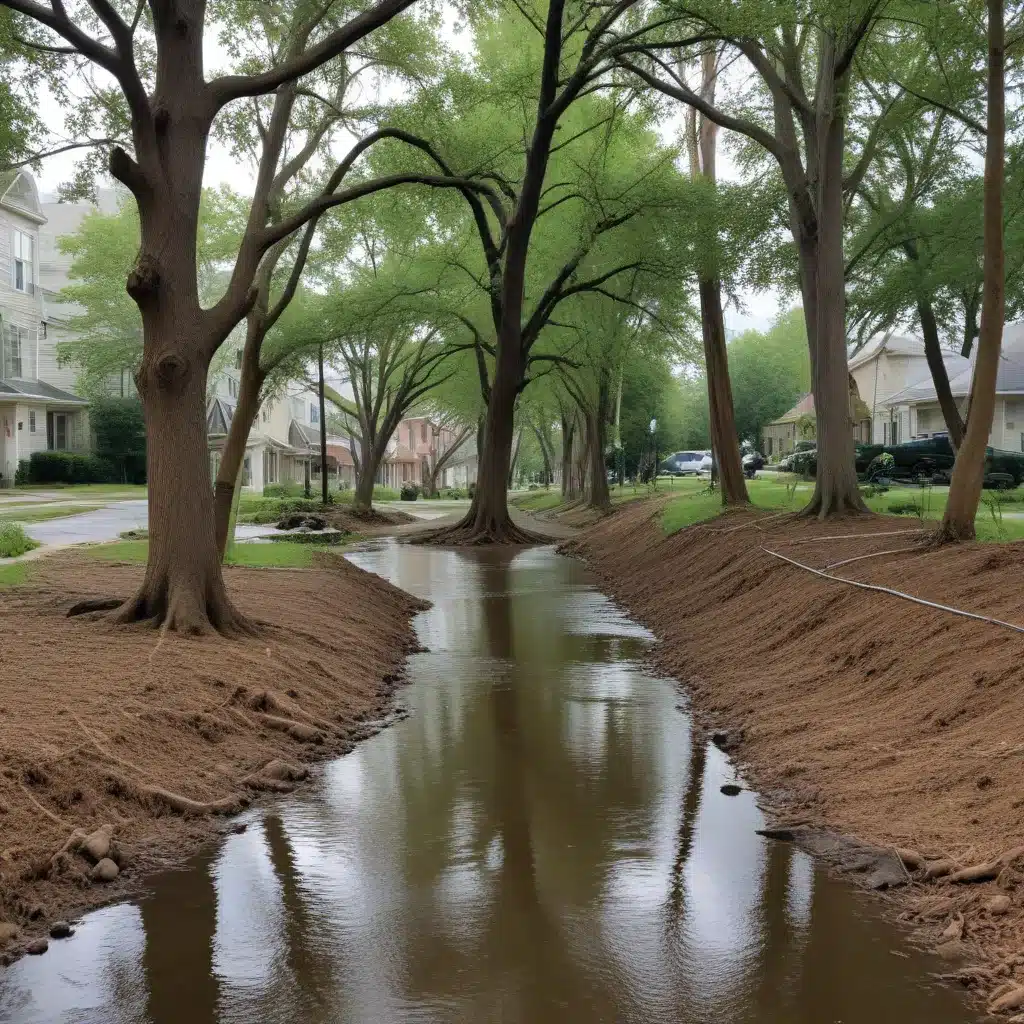
As a tree care specialist with TriCounty Tree Care, I have observed the intricate relationship between urban tree management and effective stormwater control. In this comprehensive article, we will delve into the complexities of tree removal and its influence on stormwater management, exploring strategies to mitigate flood risks through informed decision-making.
Flood Risk Factors
Environmental Conditions
The prevalence of floods is often influenced by the hydrological characteristics of a region, such as precipitation patterns, soil permeability, and topography. Impervious surfaces, like concrete and asphalt, can significantly impede the natural absorption of water, leading to increased surface runoff and the risk of flooding. Extreme weather events, exacerbated by climate change, have further amplified the frequency and intensity of flooding in many communities.
Urban Development Impacts
As urban areas continue to expand, the replacement of natural landscapes with built infrastructure has profoundly altered the dynamics of stormwater management. The removal of trees and other vegetation can disrupt the delicate balance of the urban ecosystem, reducing the interception and infiltration of precipitation, and contributing to the accumulation of stormwater runoff.
Climate Change Considerations
The impacts of climate change on stormwater management cannot be overstated. Changing precipitation patterns, rising sea levels, and the increased frequency of extreme weather events have heightened the need for comprehensive strategies to address the growing threat of floods. Tree removal, if not carefully considered, can exacerbate these challenges, making it essential to incorporate climate change adaptation into the decision-making process.
Stormwater Management Strategies
Green Infrastructure Approaches
Green infrastructure solutions, such as bioswales, rain gardens, and permeable pavements, can play a crucial role in mitigating flood risks. These nature-based approaches leverage the ecosystem services provided by vegetation, including water absorption, erosion control, and microclimate regulation. By integrating green infrastructure into urban planning and design, communities can enhance their resilience to flooding while preserving the ecological benefits of trees and other natural features.
Gray Infrastructure Solutions
Traditional gray infrastructure methods, such as storm sewers, detention basins, and levees, have long been employed to manage stormwater runoff. While these engineered solutions can provide immediate flood control, they often fail to address the underlying causes of flooding and may have unintended consequences, such as habitat fragmentation and decreased biodiversity. Striking a balance between green and gray infrastructure can lead to more sustainable and integrated stormwater management strategies.
Integrated Management Techniques
The most effective stormwater management approaches often involve a combination of green and gray infrastructure, tailored to the unique environmental conditions and development patterns of a given community. Hydrological modeling, geospatial analysis, and stakeholder engagement can help identify the optimal mix of interventions, ensuring that tree removal decisions are made in the context of a comprehensive, climate-resilient stormwater management plan.
Tree Removal Considerations
Ecosystem Impacts
The removal of trees can have significant ecological consequences, disrupting the delicate balance of the urban ecosystem. Habitat loss, altered microclimate, and reduced biodiversity are just a few of the potential impacts that must be carefully weighed when considering tree removal. Arborists and urban foresters play a crucial role in assessing the environmental value of trees and identifying alternative solutions that minimize disruption to the natural landscape.
Soil and Slope Stabilization
Trees play a vital role in soil and slope stabilization, anchoring the ground with their extensive root systems and mitigating the risks of erosion and landslides. The removal of trees, particularly in areas with steep terrain or unstable soils, can exacerbate these issues and increase the vulnerability of surrounding infrastructure to flooding and other natural disasters. Comprehensive geotechnical assessments and slope stability analyses are essential when considering tree removal in sensitive areas.
Permitting and Regulations
The removal of trees is often subject to local, state, and federal regulations, which may vary depending on the species, size, and location of the tree. Arborists and landscape architects must be familiar with the relevant permitting requirements and environmental protection laws to ensure that tree removal decisions are made in compliance with all applicable statutes and ordinances.
Flood Mitigation through Strategic Decisions
Stakeholder Engagement
Effective stormwater management and tree removal decisions require active collaboration among a diverse range of stakeholders, including municipal authorities, community organizations, environmental groups, and local residents. By fostering inclusive dialogues and transparent decision-making processes, communities can build consensus around the most appropriate strategies to mitigate flood risks while preserving the ecological and aesthetic value of their urban tree canopy.
Cost-Benefit Analysis
Evaluating the financial implications of tree removal and stormwater management strategies is crucial for ensuring the long-term sustainability of flood mitigation efforts. Cost-benefit analyses that consider both direct and indirect costs, as well as the ecosystem services provided by trees, can help prioritize interventions and guide resource allocation in a manner that optimizes environmental, social, and economic outcomes.
Long-Term Sustainability
Sustainable stormwater management and tree care practices must be embedded into comprehensive, long-term planning initiatives. This includes monitoring and evaluation of the effectiveness of implemented strategies, as well as continuous adaptation to address evolving environmental conditions and community needs. By taking a proactive and holistic approach, communities can build resilience to flooding and ensure the ongoing health and vitality of their urban tree canopy.
At TriCounty Tree Care, we recognize the pivotal role that trees play in the broader ecosystem and the resilience of our communities. By integrating sustainable stormwater management strategies with responsible tree care practices, we can work together to mitigate flood risks, preserve the natural environment, and enhance the overall quality of life for residents. Contact us today to learn more about our comprehensive tree care services and how we can help your community navigate the complex challenges of urban forestry and stormwater management.


